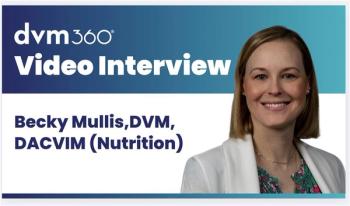
Transition cow nutrition programs: Is there one way to feed the cows? (Proceedings)
There are many ways to feed a transition dairy cow, specifically a prefresh cow. They include low-energy, high-forage diets that are identical to the diet fed far-off dry cows, the far-off dry cow ration with additional additives such as anionic salts or rumen-protected choline, or a separate prefresh ration with an energy level intermediate between the far-off dry cow ration and the fresh cow diet.
There are many ways to feed a transition dairy cow, specifically a prefresh cow. They include low-energy, high-forage diets that are identical to the diet fed far-off dry cows, the far-off dry cow ration with additional additives such as anionic salts or rumen-protected choline, or a separate prefresh ration with an energy level intermediate between the far-off dry cow ration and the fresh cow diet. While even more potential feeding programs exist, this demonstrates there are many ways to feed a prefresh dairy cow and they all may have varying degrees of success. This discussion will examine the advantages and disadvantages of different recommended feeding programs for prefresh dairy cows. This information can be used to better inform your clients as they consider feeding programs for their prefresh cows.
Much of the focus in close-up rations has centered on the energy density of the diets. Using the prediction equations of the 2001 Dairy NRC an approximately 1500 pound cow in the last few weeks prior to calving would only require around 15 Mcal of NEL/day. If that cow consumes 28 pounds of dry matter, the energy density of the ration would only need to be 0.53 Mcal of NEL/lb of dry matter. By not feeding energy in excess of requirements it is thought that the cow will be at lower risk for the development of metabolic diseases post-calving. Using this knowledge, in recent years much focus has been placed on the use of low-energy, high forage diets for prefresh cows. These rations often utilize straw to achieve their low energy density and have therefore become known as high-straw diets or birds-nest diets. Often the same diet is fed to both the far-off and prefresh cows, simplifying ration mixing on farm. Some farms may add specific additives to the ration before it is fed to the prefresh group (for example, anionic salts), but the base ration is still unchanged from that of the far-off dry cows. This has also led to this feeding style to be referred to as a one-group feeding system. These diets stand in contrast to traditional dry cow feeding systems consisting of a low-energy far-off dry cow diet and a separate prefresh diet that has an energy level intermediate between that of the far-off dry cow diet and the fresh cow lactating diet (approximately 0.70 Mcal of NEL/lb of dry matter). The advantage of having a higher energy diet for prefresh cows was thought to be an opportunity to adapt the rumen to higher energy (higher starch) diet prior to calving, thereby easing the transition into lactation. While that thought process sounds logical, research has tended to show little added benefit of such a diet over a low-energy prefresh diet, such as found in a one-group dry cow feeding program. Research and field impressions would tend to support a low-energy prefresh group or one-group system, although the possibility exists that the true advantage of a one-group system has been to get the energy density of the far-off cows lower and that achievement is actually what has produced the improvements in cow performance seem in a one-group system.
For ease of reference, the advantages and disadvantages of both a low-energy one-group system and a traditional two-group dry cow feeding program are listed below.
1. One-Group Dry Cow Feeding Program (Low-Energy - ~0.60 Mcal NEL/lb of DM)
a. Advantages
I. Less rations to be mixed on farm
II. Doesn't overfeed energy – especially to far-off dry cows
III. Provides rumen fill around time of calving
IV. Inexpensive ration
b. Disadvantages
I. May be an unpalatable/dry ration because of straw usage – added water may help with this
II. Straw/dry hay must be processed to < 2" in length or sorting will occur resulting in poor cow performance
III. Overcrowding may cause some cows to be limited on dry matter intake. Decreased DMI with these diets can be a disaster.
2. Two-Group Dry Cow Feeding Program (Far-off and Prefresh rations with Prefresh ration having an energy density of approximately 0.70 Mcal NEL/lb of DM)
a. Advantages
I. May improve energy balance and liver function around time of calving, although no milk production advantage has been observed
II. May aid rumen in adaptation to lactating diet although a significant milk advantage has not been observed
III. May provide adequate energy as dry matter intake decreases prior to calving
b. Disadvantages
I. Forces the mixing of another separate ration, taking additional time and labor
II. May overfeed energy, predisposing cows to increased risks for the development of metabolic diseases
III. May be a more expensive ration
IV. May provide less rumen fill around time of calving
When all the advantages and disadvantages are considered, the one-group, low-energy system presents an attractive option to many dairy farmers and nutritionists. If a one-group, low-energy system is used the following guidelines should be followed:
1. Aim for an energy density of 0.59-0.60 Mcal NEL/lb of dry matter to provide 15-16 Mcal NEL/day.
2. Ration dry matter should be < 50% if possible to improve palatability
3. Process straw or long-stemmed dry forage to <2" in length
4. Don't overcrowd cows – attempt to have 30" of bunk space/cow
Following these guidelines will help these rations be as successful as they possibly can be.
So with all of this information, what is the take-home message? I would propose that low-energy one-group dry cow diets provide an attractive option for feeding dry cows and improving transition cow performance. With that said, I also have observed many higher-energy prefresh rations still in use on very successful dairy farms. The common observation that I have made, regardless of dry cow program, is that the transition cows are very well managed and that they are placed in low stress environments. To me, this highlights that good managers can be successful in different systems and that oftentimes it is not so much about the ration that we feed, but how we manage cows beyond nutrition. I would encourage veterinarians to keep an open mind when helping to design a dry cow nutrition program and realize that there is more than one way to feed a dry cow – you just need to find what works best on that specific dairy. Every farm is different and a blanket program will not work for everybody.
Newsletter
From exam room tips to practice management insights, get trusted veterinary news delivered straight to your inbox—subscribe to dvm360.






